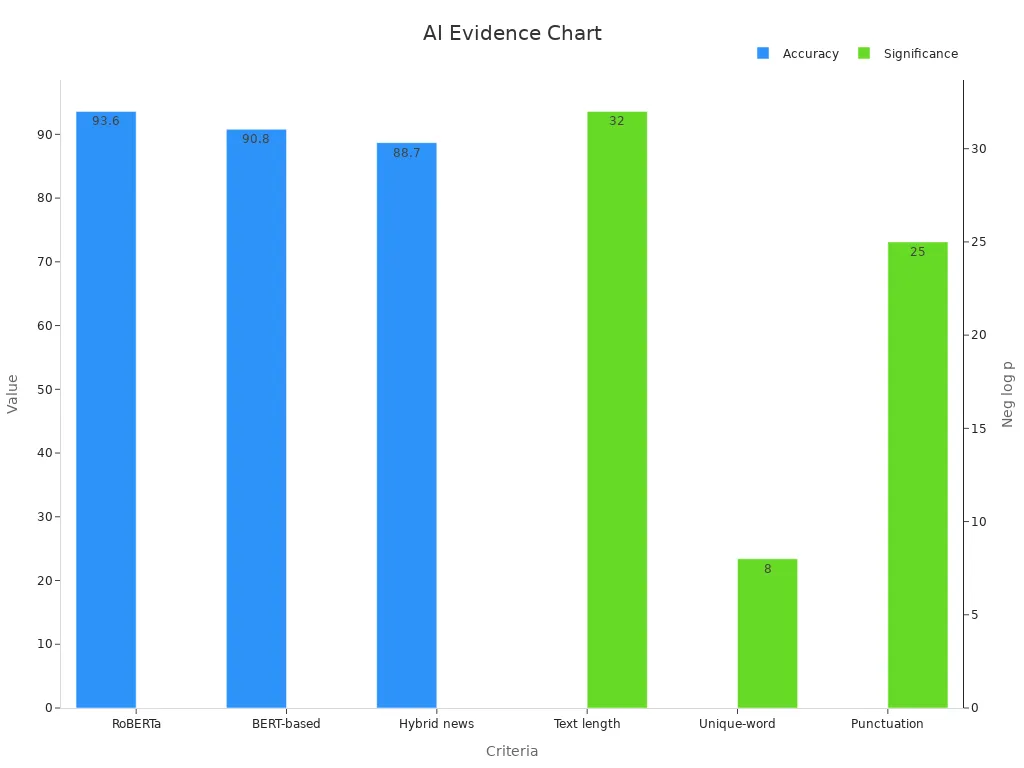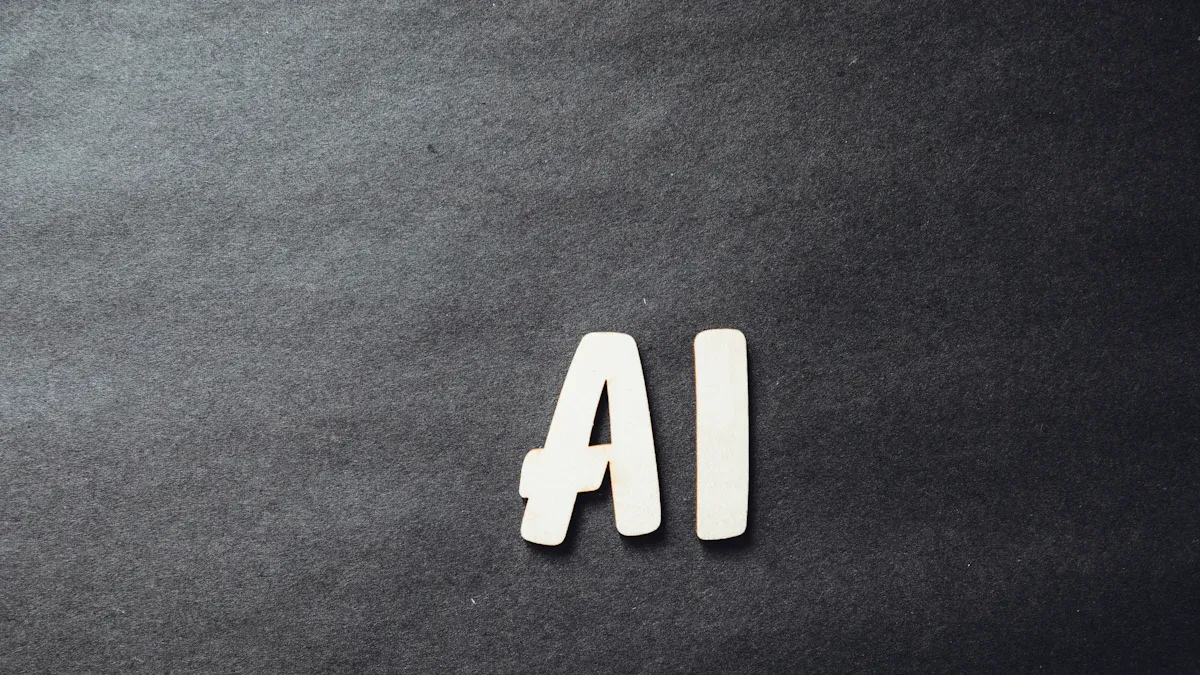
You probably notice more teachers and students using ai for writing and editing than ever before. In 2025, the best free AI generated text detector helps you spot ai-generated text and keeps academic work honest. Universities now rely on these tools since 68% have built them into their systems.

You want accuracy and easy-to-use platforms. Some models detect ai text with over 90% accuracy, but challenges remain. Teachers need free access and tools that fit real classroom needs. As educators and students face new risks, you need solutions that support academic integrity.
Key Takeaways
-
Free AI text detectors help students and teachers spot AI-generated writing to keep schoolwork honest and original.
-
No single tool is perfect; using multiple detectors and reviewing your work carefully improves accuracy and fairness.
-
Understand each tool’s limits, follow school rules, and communicate with teachers if your work is flagged to protect your academic integrity.
Best AI Detection Tools

Overview
You want to find the best ai detection tools that actually work for your classroom or study needs. With so many options out there, it can feel overwhelming. The good news? You have access to several free ai generated text detector platforms that help you spot ai-generated content and keep your work original. These tools are not just for teachers—they help students, too. You can use them to check your essays, reports, or any writing before you submit.
Most of the best ai detectors focus on accuracy, speed, and ease of use. Some even give you detailed reports or highlight which sentences look like ai-generated text. Many schools and universities now use these ai detection tools to support academic integrity. You will see names like ZeroGPT, Winston AI, CopyLeaks, Eduwriter.ai, Scribbr, Grammarly, Turnitin (free version), Originality, Compilatio Magister+, and Content at Scale. Each one brings something unique to the table.
Tip: Try more than one ai content detector for important assignments. Some tools catch things others miss!
Key Features
Let’s break down what makes each of the best ai detection tools stand out. Here’s a quick look at their strengths, limits, and how they fit into education:
|
AI Detector |
Accuracy Rate / Detection |
Free Access Limits |
Main Strengths for Teachers & Students |
Educational Suitability |
|---|---|---|---|---|
|
Free plan, word count limits |
High accuracy, confidence scores, easy reports |
Widely used in schools, user-friendly |
||
|
Winston AI |
99.98% (claimed) |
Free trial, paid plans |
Advanced features, color-coded results, multi-format |
Used by schools, strong reporting |
|
CopyLeaks |
100% on mixed samples |
Free plan, limited scans |
Reliable, detailed feedback, used in research |
Trusted in academic publishing |
|
Eduwriter.ai |
High (varies by model) |
Free basic plan |
Simple interface, quick checks, student-friendly |
Good for quick classroom checks |
|
Scribbr |
High (varies by text) |
Free limited checks |
Plagiarism + ai detection, clear feedback |
Great for essays and assignments |
|
Grammarly |
Moderate (AI detection) |
Free plan, limited ai detection |
Writing help + ai content detection |
Useful for drafts and grammar |
|
Turnitin (free) |
High (in studies) |
Free for some institutions |
Deep analysis, trusted by universities |
Standard for academic integrity |
|
Originality |
85-100% (studies show) |
Free trial, paid after limit |
Detailed breakdown, robust against paraphrasing |
Best for research and originality |
|
Compilatio Magister+ |
High (varies by use) |
Free trial |
Plagiarism + ai detection, multi-language |
Good for international students |
|
Content at Scale |
High (AI detection) |
Free limited checks |
Fast, bulk scanning, easy to use |
Great for teachers with many papers |
You can see that each ai generated text detector has its own strengths. For example, ZeroGPT and CopyLeaks both show high accuracy in studies, with ZeroGPT reaching up to 98% and CopyLeaks correctly identifying all mixed samples. Winston AI claims industry-leading accuracy and offers color-coded results, which makes it easy for you to spot ai-generated content at a glance. Originality stands out for its detailed breakdowns and strong performance against paraphrased ai-generated text, which is important if you worry about students using rewording tools.
Some ai detectors, like Turnitin and Scribbr, combine plagiarism checking with ai content detection. This helps you catch both copied and ai-generated text in one scan. Grammarly and Eduwriter.ai focus on user experience, making them perfect for quick checks or for students who want to improve their writing before submitting.
Note: Free access plans often limit how many words or documents you can scan each month. For example, GPTZero lets you scan up to 10,000 words per month on the free plan. Many free ai detection tools also have lower sensitivity when dealing with paraphrased or very short text, so always check the limits before you rely on just one tool.
You might wonder how these tools compare in real classrooms. Studies show that ZeroGPT, CopyLeaks, and Turnitin perform well in educational settings, with high accuracy rates and easy integration into school systems. Winston AI is also popular among teachers, though detailed accuracy data is still growing. Originality and CopyLeaks both shine when you need to check for originality and handle tricky cases like paraphrased ai-generated content.
When you use the best ai detectors, you help protect academic integrity and make sure your work is truly your own. These ai detection software options give you peace of mind, whether you are a teacher checking assignments or a student double-checking your essay.
Quick Fact: Free ai content detectors often have strict word count limits and may miss some ai-generated text, especially if it has been paraphrased. For big projects, you may need to combine several ai detection tools or upgrade to a paid plan.
If you want to see how these ai detection for teachers tools stack up, here’s a quick comparison of some popular options:
|
Tool |
Interface Usability |
Features & Reporting |
Accuracy |
Integration Impact |
|---|---|---|---|---|
|
ZeroGPT |
Intuitive, easy to use |
Detailed reports, highlights |
High |
User-friendly |
|
Originality |
Streamlined, user-friendly |
Multi-format, robust analysis |
Superior |
Best for research |
|
Winston AI |
Multi-format, color-coded |
Advanced, comprehensive |
Superior |
Seamless |
|
CopyLeaks |
Simple, clear feedback |
Reliable, detailed |
High |
Trusted |
You can see that the best ai detection tools offer a mix of accuracy, usability, and educational value. Some focus on deep analysis, while others make it easy for you to scan lots of text quickly. No matter which ai content detector you choose, always check the free access limits and try a few to find what works best for your needs.
Why Use AI Text Detection
Academic Integrity
You want your schoolwork to reflect your own effort. That’s why academic integrity matters so much. When you use ai text detection, you help keep your writing honest. Teachers rely on these tools to spot ai-generated text and make sure students submit original assignments. If you use ai writing tools, you might feel tempted to copy or let the ai do all the work. But with ai writing detection, teachers can see if your essay or report is truly yours.
Check out this table showing how things have changed with ai and plagiarism detection:
|
Metric/Aspect |
Before AI Text Detectors |
After AI Text Detector Implementation |
|---|---|---|
|
Average plagiarism rate in assignments |
Up to 33.25% in some regions |
|
|
Student cheating prevalence |
95% reported cheating |
15% affected by fake term papers |
|
Educator vs student AI misuse admission |
27% educators, 55% students |
68% of schools now use ai detection |
You can see that as ai-generated writing becomes more common, schools use more ai plagiarism detection to protect academic integrity. Still, some students and teachers struggle with what counts as cheating. That’s why you need clear rules and strong detection tools.
Preventing AI Misuse
AI writing tools make it easy to create essays, but not all students use them fairly. Some try to pass off ai-generated content as their own. With ai text detection, teachers can catch this kind of misuse. You help keep your school honest when you check your writing before turning it in.
Detection is always changing. AI-generated text gets better, but so do detection tools. Schools now use more than just software—they might ask you to explain your writing or store your assignments for future checks. You play a big part in keeping academic integrity strong by using ai writing detection and plagiarism detection before you submit your work.
Remember: Using ai-generated writing without checking can hurt your learning. Always review your text and make sure it shows your real skills.
AI Generated Text Detector Comparison

Accuracy
When you look for an ai generated text detector, you want one that can spot ai-generated text with high accuracy. Not all ai detectors work the same. Some, like Lite 1.0.1, reach almost perfect accuracy—up to 100% on the latest models and a false positive rate as low as 0.5%. But most ai detection tools do not hit these high marks. For example, ZeroGPT sometimes misidentifies 48% of cases, and Originality.ai can miss even more. The FTC even found that some companies claim 98% accuracy, but real tests show only about 53%. Only a few ai detectors meet the highest standards, so you should always double-check important work.
|
AI Detector |
Accuracy Range |
False Positive Rate |
|---|---|---|
|
Lite 1.0.1 |
98.3%-100% |
0.5% |
|
ZeroGPT |
Up to 98% |
48% misidentification |
|
Originality.ai |
85-100% |
76% misidentification |
Usability
You want ai detectors that are easy to use. ZeroGPT and GPTZero have simple interfaces and quick setup. Turnitin fits right into your school’s system, so you do not need extra steps. Some tools, like AI Content Detector, work well for academic writing but feel less friendly for creative work. If you want to check lots of text fast, Content at Scale gives you clear instructions and bulk scanning.
Free Access Limits
Most ai detection tools offer free plans, but you will see limits. Some let you scan only a few thousand words each month. Others, like Turnitin, may be free only if your school pays for it. Always check how many scans you get before you rely on one ai generated text detector. If you need to check for originality often, you might need to use more than one tool or look for special student access.
|
AI Detector |
Accuracy Level |
Usability |
Free Access Limits |
|---|---|---|---|
|
ZeroGPT |
Very high (98%+) |
User-friendly |
Word count limits |
|
GPTZero |
High for GPT-3/4 |
Academic focus, easy |
Limited scans per month |
|
Turnitin AI |
Good for plagiarism |
Easy academic integration |
Free for some institutions |
|
Content at Scale |
High for GPT models |
Clear, bulk scanning |
Limited free checks |
Tip: Try more than one ai detection tool to boost originality and catch what others might miss.
Choosing AI Detectors
What to Consider
Picking the right ai detection tool can feel tricky. You want something that fits your classroom or study habits. Start by looking at how well the tool spots both ai-generated writing and real student work. Some detectors do a great job with older ai models, but newer ones like GPT-4 can fool them. Make sure the tool you choose keeps up with the latest ai changes.
Here’s a quick checklist to help you decide:
-
Check the sensitivity and specificity. You want a balance so the tool catches ai-generated writing but doesn’t flag your real writing by mistake.
-
See if the detector works with different ai models. Some tools handle GPT-3.5 well, but struggle with GPT-4.
-
Look for regular updates. The best ai detection for teachers comes from tools that keep improving.
-
Find out if the tool works with your school’s system, like Google Classroom or other LMS platforms.
-
Make sure it can scan longer writing, especially if your assignments are more than 300 words.
-
Use tools that give clear scores or reports, so you know what the results mean.
Tip: Don’t rely only on ai detection. Combine it with your own review and talk with teachers if you have questions.
Matching Needs
You have your own way of learning and writing. Some students write essays, while others work on reports or creative projects. Teachers also have different needs. If you check lots of assignments, you might want ai detection for teachers that scans in bulk. For quick homework checks, a simple tool works best.
Try to match the ai detector to your writing style. If you use lots of sources or mix your own ideas with ai-generated writing, pick a tool that explains its results. Stay updated, because new ai detectors appear every year. The right choice helps you keep your writing honest and supports your learning.
AI Detection Concerns
False Positives
You might worry about your work being flagged as ai when you wrote it yourself. This happens more often than you think. Sometimes, ai detectors mark human writing as ai-generated. Studies show that no single ai tool is perfect. In fact, using three or more ai detectors together lowers the chance of mistakes, but it does not remove them completely. Non-native English speakers and students with unique writing styles face more false accusations. These mistakes can hurt your grades and even cause unfair academic penalties. Schools now suggest using several ai tools, keeping drafts, and showing your writing process to prove your work is original.
If your work gets flagged, talk to your teacher and share your drafts. Human judgment is still important in these cases.
Ethical Use
You want ai to help learning, not create new problems. Some ai detectors flag non-native English writers much more often. Over 60% of TOEFL essays from these students get marked as ai, even when they are not. This bias can lead to unfair treatment and even break privacy or anti-discrimination rules. Experts say you should not rely only on ai for big decisions. Instead, schools need clear rules, open communication, and a focus on trust. Teachers and students should work together to use ai in a fair and honest way.
Tool Limitations
You should know that ai detectors have real limits. They often misclassify human writing that has just a little ai help. Many tools cannot tell how much ai was used in your work. Some ai detectors only get it right about 40% of the time. If you change your writing style or add spelling mistakes, you can trick the ai. These tools also struggle with older ai models and can be fooled by simple tricks. Because of these problems, you should always combine ai with human review.
-
No ai tool works perfectly in every situation.
Always double-check important work and ask for a teacher’s review if you feel unsure.
You want the best results from free ai detectors, but studies show accuracy rates often fall below 80%. Paraphrasing drops ai detection by 21%. Try several ai tools for your writing. Stay updated, use ai responsibly, and always review your ai results. Share your ai experiences or questions below!
التعليمات
What should you do if an ai detector marks your work as ai-generated?
You should talk to your teacher right away. Show your drafts and explain your writing process. Most teachers understand that ai detectors can make mistakes.
Can you trust free ai detectors for important school assignments?
Free ai detectors help a lot, but they sometimes miss things. For big projects, try more than one ai tool. Always double-check your work before you turn it in.
How can you use ai detectors without breaking school rules?
Always follow your school’s policy. Use ai detectors to check your own writing, not to accuse others. If you feel unsure, ask your teacher for advice.







